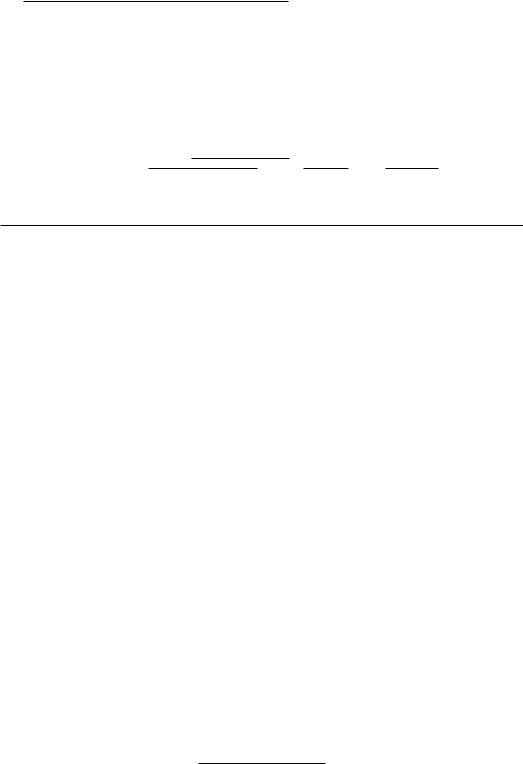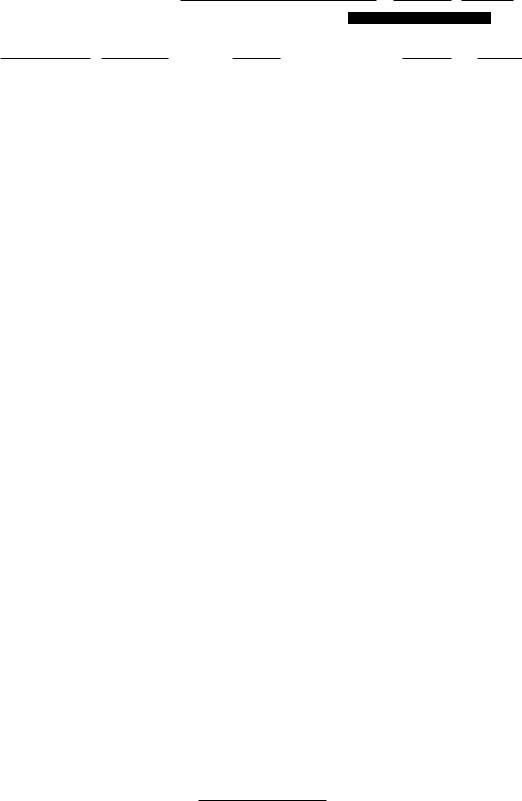
CFA Level 1 (2009) - 3
.pdf
Study Session H
Cross-Reference to CFA Institute Assigned Reading #34 - Understanding the Cash How Statement
Sale of bonds |
$5,000 |
|
|
Repurchase of slock |
( I 0,0(0) |
Cash dividends |
(3,500) |
|
|
Cash |
flolY from financing |
($R,500) |
|
|
|
|
|
Total cash flow:
Cash flow from operJtions Cash flow from investmenlS Cash HolY from financing
'I<Hal cash Row
$42,500 (10,000)
(8,500)
$24,000
The rotal cash flow of $24,000 is equal to the increase in the cash account. The difference between beginning cash and ending cash should be used as a check figure to ensure that the total cash flow calculation is correct.
Both IrRS and U,S, GAAP encourage the use of a st;!tcmenr of cash flows in the direct formaL Under U,S, CAAP, a statemenr of cash flows under the direer method must include footl1ote disclosure of the indirect method, Most companies however, report cash flows using the indirect method, which requires no additional disclosure. The next
LOS illustrates the method an analyst will lise to create a statement of cash flows in the direer method format when the company reports using the indirect method.
LOS 34.g: Describe the process of converting a statement of cash flows from the indirect to the direct method of presentation.
The only difference between the indirect and direct methods of presentation is in the cash flow from operations (CFO) section. CFO under the direct method can be
computed using a combination of the income statement and a statement of cash flows prepared under the indirect method.
There are two major sections in CFO under the direct method: cash inflows (receipts) and cash outflows (payments). We will illustrate the conversion process using some frequently used accounts. Please note that the list below is for illustrative purposes only and is far from all-inclusive of what may be encounrered in practice. The general principle here is to adjust each income statement item for its corresponding balance sheet accounts and to eliminate noncash and nonoperating transactions.
©2008 Kaplan Schweser |
Page 121 |

Study Session 8
Cross-Reference to CFA Institute Assigncd Rcading #34 - Understanding the Cash Flow Statcment
C'llSh (o/Il'etio115 jimn (/lJtOrrJ('rJ:
I.Begin wilh nct sale~ from the incol11e stalemenl.
2.Subtracr (add) any incrL'ase (decrease) in the ;ICCOUIHs receivable balance as reported in the indirecr method. If the company has sold more on credit than has heen colleclcd ['rom customers, accoulHs rcu:ivahle will incrcasc and cash collcclions will
IK'less than nct sales.
3.Add (subtract) an increase (decrease) in unearned revenue. Unearned revenue includes cash advancL's from cusromers. Cash received from customers when the goods or services have yet to be delivered is not included in net sales, so thL' advances must be added to net sales in order to calculate crsh collecrions.
ellJh jJil)!rrJ01!J" to s/lpp/ias:
]. Begin with cost of goods sold (COCS) as reponed in the income st:ltcmcIH.
2.Ifdcpreci:rrion andlor ;tmorril.alion lLl\'l' been inclnded in coes (lhe}' inucase COGS), thesc itl:ms must be added hack to cues when compuling the cash p;litl
to suppliers.
3.Reduce (increase) COGS by any increase (decrease) in the accounts payable balance as reported in the indirect method. Tfpayables have increased, then more was speIH on cn:dit purchases during the period than was paid on existing payahles, so cash
paymclHs are reduced by the amOlllH of the increase in payables.
4.Add (subtract) any increase (decrease) in the inventory balance as disclosed in the indirect method. Increases in inventory are not included in COGS for the period but still represent the purchase of inputs, so they increase cash paid to suppliers.
5.Subtract an inventory write-off that occurred during the period. An inventory write-off, as a result of applying the lower of cost or market rule, will reduce ending inventory and increase COGS for the period. However, no cash flow is associated wi th the wri te-off.
Other items in a direct method cash How statement t~)llow the same principles. Cash taxes paid, for example, can be derived by starting with income tax expense on the income statement. Adjustmenr must be made for changes in related balance sheet accounts (deferred tax assets and liabilities, and income taxes payable).
Cash operating expense is equal to selling, general, and administrative expense (SG&A) from the income statement, increased (decreased) for any increase (decrease) in prepaid expenses. Any increase in prepaid expenses is a cash outAow that is not included in SG&A for the current period.
Page 122 |
©2008 Kaplan Schweser |

Study Session 8 Cross-Rcfcrence to CFA Institutc Assigncd Rcading #34 - Undcrstanding the Cash Flow Statcmcnt
Example: Direct method for.computing CFO
Prepare a cash flow statement using the direct method using the indirect statement of cash flows, balance sheet and income statement from the previous example.
Answer:
ProfeJSor~' Note: There are mallY /Uays to tllillk abollt tllese caiclilatiolls ami lots ofsources amlwes alld pillses ami mil1wes to keep tmel? of It's etlSier if)'oll lise tl "+" sign for net sales and a "-" sign for cost ofgoods JOld and other cash expemes IIsed as the starting points. Doing so lUill allow yo II to
co nsisteJItly follow the rule that tm increase ii, assets or decrease in litlbilities is a use ofcash find a deererlse in assets or an inaease ill liabilities is a sOllrce. 1Ve'lluse this approach in the answer to the example. Remember, SOltreeS are always + alld IIses an' allUflYs-.
The calculations that follow include a reconciliation of each account, analyzing the transactions that increase and decrease the account tor the period. As previously discussed, this reconciliation is useful in understanding the interrelationships between the balance sheet, income statement, and cash flow statement.
Cash from operations:
Keep track of the balance sheet items used to calculate CFO by marking them off the balance sheet. They will not be needed again when determining CFI and CFF.
cash collections = sales - increase in accoun ts receivable = $100,000 - $1,000 = $99,000
beginning receivables + sales - cash collections = ending receivables = $9,000 + $100,000 - $99,000 = $10,000
cash paid to suppliers = - COGS + decrease in inventory + increase in accounts payable = -$40,000 + $2,000 + $4,000 = -$34,000
beginning inventory + purchases - COGS = ending inventory = $7,000 + $38,000 (not provided) - $40,000 = $5,000
beginning accounts payable + purchases - cash paid to suppliers = ending accounts payable = $5,000 + $38,000 (not provided) - $34,000 = $9,000
cash wages = - wages - decrease in wages payable = -$5,000 - $3,500 = -$8,500
beginning wages payable + wages expense - wages paid = ending wages payable = $8,000 + $5,000 - $8,500 = $4,500
cash interest = - interest expense + increase in interest payable = -$500 + $500 = 0
beginning interest payable + interest expense - interest paid = ending interest payable = $3,000 + $500 - $0 = $3,500
©2008 Kaplan Schwcscr |
Page 12.1 |

Study Session 8
Cross-Reference to CFA Institute Assigned Reading #34 - Understanding the Cash Flow Statement
cas!J tflXes = -tax expense + increase in taxes payable + increase in deferred tax liability
= -$20,000 + $1,000 + $5,000 = -$14,000
beginning taxes payable + beginning deferred tax liability + tax expense - taxes paid = ending taxes payable + ending deferred tax liability = $4,000 + $15,000 + $20,000 - $14,000 = $5,000 + $20,000
Cash collections |
$')'),000 |
Cash to suppliers |
(34,000) |
Casl! wages |
(8,500) |
Cash in terest |
o |
Cash taxes |
( [·'i,OOO) |
|
|
Cash flow li'om 011er,lliolls
LOS .)·4.h: Analyze and interpret a cash flow statcmcllt llsing both toral currency amounts and common-size cash How statements.
lv/ajol' Sources and Uses of Cash
Cash flow analysis begins with an eval uation of the flrm's sources and uses of cash from operating, investing, and financing activities. Sources and uses of cash change as the firm moves through its life cycle. For example, when a finn is in the early stages of
growth, it may experience negative operating cash flow as it uses cash to flnance increases in inventory and receivables. This negative operating cash flow is usually financed externally by issuing debt or equity securities. These sources of financing are not sustainable. Eventually, the firm must begin generating positive operating cash flow or the sources of external capi tal may no longer be available. Over the long term, successful firms must be able to generate operating cash flows that exceed capital expenditures and provide a return to debt and equity holders.
Operating Cash Flow
An analyst should identify the major determinants of operating cash flow. Positive operating cash flow can be generated by the firm's earning-related activities. However, positive operating cash flow can also be generated by decreasing noncash working capital, such as liquidating inventory and receivables or increasing payables. Decreasing noncash working capital is not sustainable, since inventories and receivables cannot fall below zero and creditors will not extend credit indefinitely unless payments are made when due.
Operating cash flow also provides a check of the quality of a firm's earnings. A stable relationship of operating cash flow and net income is an indication of quality earnings. (This relationship can also be affected by the business cycle and the firm's life cycle.) Earnings that significantly exceed operating cash flow may be an indication of aggressive (or even improper) accounting choices such as recognizing revenues too soon or delaying the recogni tion of expenses. The variability of net income and operating cash flow should also be considered.
Page 124 |
©2008 Kaplan Schweser |

StUdy Session 8 Cross-Reference to CFA Institute Assigned Reading #34 - Understanding the Cash flow Statement
Investing Cash Flow
The sources and uses of cash from investing activities should be examined. Increa.~i!lg capital cxpenuirures, a use of cash, is usually an indication of growth. Conversely, a firm may reduce capital expenditures or even sell capital assets in order to save or generate cash. This may rcsult in highcr clsh outflows in the future as older assC[s are replaced or growth resumes. As meIltioned above, generating operating cash flow that exceeus capiLli expenditures is a desirable trait.
Financing Cash Flow
The financing activities section of the cash flow statemeIlt reveals information about whether the firm is generating cash How by issuing debt or equity. It also proviues information about whether the fi.rm is using cash to repay debt, reacquire srock, or pay dividends. for example, an analyst would certainly want ro know if a firm issued debt and used the proceeds to reacquire srock or pay dividends ro shareholders.
Common-Size Cash Flow Statement
likc the income staremel1l and balance sheer, common-size analysis can be used to analyze the cash How statement.
The cash flow statement can be convened to common-size format by expressing each line item as a percentage of revenuc. Alternatively, each inflow of cash can be expressed as a percentage of ((Hal cash inflows, and each outAow of cash can be expressed as a percentage of lOtal cash outflows.
Example: Common-size cash Row statement analysis
Triple Y Corporation's common-size cash flow statement is shown in the table below.
Explain the decrease in Triple Y's total cash flow as a percentage of revenues.
Triple Y Corporation
Cash Flow Statement (Percent of Revenues)
Year |
20X9 |
20X8 |
20X7 |
Net income |
13.4% |
13.4% |
13.5% |
Depreciation |
4.0% |
3.9% |
3.9% |
Accounts receivable |
-0.6% |
-0.6% |
-0.5% |
Inventory |
-10.3% |
-9.2% |
-8.8% |
Ptepaid expenses |
0.2% |
-0.2% |
0.1% |
Accrued liabilities |
5.5% |
5.5% |
5.6% |
Operating cash flow |
12.2% |
12.8% |
13.8% |
Cash ftom sale of fixed assets |
0.7% |
0.7% |
0.7% |
Purchase of plant and equipment |
-12.3% |
-12.0% |
-11.7% |
Investing cash flow |
-11.6% |
-11.3% |
-11.0% |
Sale of bonds |
2.6% |
2.5% |
2.6% |
Cash dividends |
-2.1% |
-2.1% |
-2.1% |
Financing cash flow |
0.5% |
0.4% |
0.5% |
Total cash flow |
1.1% |
1.9% |
3.3% |
©2008 Kaplan Schweser |
Page 125 |

Srudy Session 8
Cross-Reference to Cl--/\ Institute Assigned Reading #34 - Understanding the Cash Flow Statement
Answer:
Operating cash flow has decreased as a percentage of revenues. This appears [0 be due largely to accumulating inventories. Investing activities, specificlily purchases of plant and equipment, have also required an increasing percentage of the firm's cash flow.
(( l\ ~·-i j. l'~.,!-,l~l.:i! ~~jl(i (_ :1( l;!"L:. \1 "·'(FlIt)'l'lHd<.Hftl.."r l.~!,l.,h L:(J-~'" r ;1.l:.U\
Free cash flow is a measure of c3.sh that is available for discn:>tionary purposes. This is the cash Aow that is available once the firm has covered its capital expenditures. This is a fundamental cash How measure and is often used for valuation. There 3.re measures of free cash Aow. Two of the more common measures are free cash flow (() the firm and free cash How [0 equity.
Free Cash Flow to the Firm
free cash flow to the firm (FCFF) is the cash available to all investors, both equity owners and debt holders. rCFr call be calculated by starting with either nl:( income or operating cash Aow.
FCFF is calculJ.ted from net income as:
FCH = NI + NCC + lInt x (1 - tax rate)] - FeInv - WOnv
where:
NI = net IIlcome
NCe |
= noncash charges (depreciation and amortization) |
In t |
= III terest expense |
FClnv |
= fixed capital investment (net capital expenditures) |
WeIllv = working capit3.l investment
Note that interest expense, net of tax, is added back to net income. This is because FCFF is the cash Aow available to stockholders and debt holders. Since interest is paid to (and therefore "available to") the debt holders, it must be included in FCFF.
FeFF can also be calculated from operating cash Aow as:
FCFF = CFO + [Int x (l - tax rate)] - FClnv
where:
CFO = cash flow from operations Int = interest expense
FClnv = fixed capital investment (net capital expenditures)
It is not necessary to adjust for noncash charges and changes in working capital when starting with CFO, since they are already reflected in the calculation of CFO. For firms that follow IFRS, it is not necessary to adjust for interest expense that is included as a part of financing activities. Additionally, firms that follow IFRS can report dividends paid as operating activities. In this case, the dividends paid would be added back to
CFO. Again, the goal is to calculate the cash flow that is available to the shareholders
Page 126 |
©2008 Kaplan Schweser |

Study Session R
Cross-Reference to CIA Instilllte Assigned Reading #34 - Understanding the Cash Flow Statement
alld dclll holdns. Ir is nor necessary to adjust dividends for taxes since dividends paid are not tax dnluclihk.
Free Cash How to Equity
hee cash How to equity (FCFE) is rhe cash How that would be availahlc Cor distribution tD COllllllDn shareholdns. HTL':GIn be ct!cuL!rnl as follows:
rCT l·:= CH)- \·Clnv + Net borrowing
where: |
|
|
eFO |
= cash Row frolll operations |
|
r;Clnv |
= fixed capital invesrlllent (ncr capiral expenditures) |
|
Ncr |
bO!Towillg |
= debr issued Llt-bt repaid |
If lirms |
t har follow |
j I;RS have sulJlracted dividl"llds paid in calculating CHi, dividends |
lllUSt be added hack whcn calcularing rCFF. Other Cash How Ratios
Just as with the income sratemelH and halance sheet, thc cash How starcment can bc analyzed hy comparing the cash 110ws either over time or to dlOse of or her finns. Cash How rarios can be caregorized as performance rarios and coverage rarios.
Pnforl/lil/la R"tios
The cash flow-to-revenue ratio measures rhe arnOUlH of operating cash How generated for each dollar of revenue.
CFO
Cash flow-to-rcvcnue = --~~- ncr revcnuc
Thc cash return-on-assets ratio llleaSlllCS the return oC operating cash flow atlrihurcd to all providers of capiral.
CRl
Cash rellirn-on-assers = --------
average (olal assets
The cash return-an-equity ratio measures the return of opera ring cash flow attribured to shareholders.
Cash rcturn-on-equity =-= |
ero |
_ |
|
|
average roral equIty |
The cash-to-income ratio measures rhe abiliry to generate cash from firm operarions.
eTO
Cash-to-income = ------
operatIng Income
Cash flow per share is a variation of basic earnings per share measurcd by llsing CfO insread of nct income.
©2008 Kaplan Schwescr |
Page 127 |

S(Udy Se~sion 8
Cross-Reference to CFA Insti(lJte Assigned Reading #34 - Understanding the Cash Flow Statemc(l(
ero - preferred dividends Cash Ilow per share = -------- ' ---
weighted average number of comm~nshares
Coverage Ratios
The debt coverage ratio measures financial risk and leverage.
CPO
Debt coverage =
total debt
The interest coverage ratio measures the firm's ability to meet its interest obligations.
|
C:l~O + interest paid + taxes paid |
Interest coverage = |
|
|
interest paiJ |
The reinvestment ratio measures the Firm's ability to acquire long-term assets with |
|
opnating cash How. |
|
Reinvestment .'--c |
-~-----CFO ~----- |
|
cash paid for long-term assets |
The debt payment ratio measures the firm's ability to satisfy long-term debt with operating cash How.
ero
Debt payment = ------------
cash long-term debt repayment
The dividend payment ratio measures the firm's ability to make dividenJ payments from operating cash flow.
· d d |
payment = |
eFO |
D IVI en |
dividends paid |
|
|
|
The investing and financing ratio measures the firm's ability to purchase assets, satisfy debts, and pay dividends.
CFO
Investing and financing = ----------------------
cash outflows from investing and financing activities
Page 128 |
©2008 Kaplan Schwcser |

Study Session 8 Cross-Reference to CfA Institute Assigned Reading 1134 - Understanding the Cash Flow Statement
f~~ :. - ' .'" |
' . \ |
(KEV: ~O~GEPT.S |
. ' |
I
... " |
- |
- ' 'l'"~.." " . : ' . 'f |
- |
, |
• |
l.OS .H.a
Cash flow from operating activities (CFO) comisrs of the inflows and outflows of cash resulting from tramactions [har affect a firm's ncr income.
Cash flow from investing activiries (CFO consists of the inflows and ourflows of cash resulting from rhe acquisition or disposal of long-term assets and certain invesrmenrs.
Cash flow from financing activities (CFF) consists of rhe inflows and outflows of cash resulting from rransactions affecting a firm's capital strucrure, such as issuing or repaying debr and issuing or repurchasing srock.
IOSH.h
Noncash invesring and flnancing acrivities, such as raking on debr to rhe seller of a purchased asset, are not reponed in rhe cash flow SLHemelH bur musr be disclosed in rhe I()()rtlores or a supplemenral schedule.
I OS Yl.l
Under U.S. GAAP, dividends paid are financing acrivities. Interest paid, inrerest received, and dividends received arc operati ng acrivi ries.
Under IFRS, dividends paid and interest paid can be reported as either operating activities or financing activities. Interest received and dividends received can be reponed as either operating activities or investing activities.
LOS .1!/.d
Under the direct method of presenting CFO, each line item of the Jccrual-bJsed income statement is adjusted to get cash receipts or cash payments.
Under the indirect method of presenting CFO, net income is adjusted for transactions that affect net income but do not affect operating cash How, such as depreciation and gains or losses on asset sales.
LOS .J4.c
The cash flow statement reconciles the beginning and ending values of cash on the balance sheet.
Differences between transactions reported on an accrual basis (on the income statement) and their effeer on cash flows (reported on the statement of cash Hows) result in increases or decreases in balance sheet items.
LOS .H.f
The direct method of calculating CFO is operating activi ties.
•Cash collections from customers-sales adjusted for changes in receivables and unearned revenue.
©2008 Kaplan Schweser |
Page 129 |

Study Sessioll 8
Cross-Rcfercncc to Cl~A Institute Assigncd Rcading #34 - Understanding thc Cash Flow Statemcnt
•Cash paid for inputs--COGS adjusted for changes in inventory and accoulHs
payahle. I
•Cash operating expenses---SC&A adjustcd for changes in related accrued liabilities or prepaid expenses.
• Cash interest paid~intcrestexpense adjusted for the change in il1lerest payable
•Cash taxes paid~income tax expense adjusted for ch~lnges in taxes payable and changes in dcfcrred LIX assets and liabilities.
Thc indirect method of calculating CFO begins with net incomc and adjusts it for gains or losses rdated to investing or financing cash fJows, noncash charges to income, and changes in balance shcet operating items.
CFl is calculated by determining the changes in asset accounts that result from invesrll1g activities. The cash flow ['rom selling an asset is irs book value plus any gain on the saiL (or minlls any loss 011 thc sale).
(TF is lhc Slll11 of'net Clsh /lows frolll creditors (IlCW horrowings minus prilllipal rqnil!l and ncr cash Bows frolll shareholders (ncw equity issued minus SILHC rcpurchases minus cash d ividends
LOS .11.g
An indircct cash fJow sratemcnr can be convertcd to a dircct cash flow statcment by adjusting each income statement account for changes in associated balance sheet accounts and by eliminating noncash and non-operating itcms.
LOS YLh
An analyst should determine whether a company is generating positive operaling cash /lmv over time that is grc~lter than its capital spending nceds and whether the company's accounting policies arc causing reponed earnings to diverge from operating cash flow.
A common-size cash flow statement shows each ircm as a percentage of revenue or shows each cash inflow as a percen rage of total inflows and each outflow as a percentage of toral
Oll tBows.
LOS.H.i
Free cash flow to the firm (FCFF) is rhe cash available to all investors, both equiry owners and debt holders.
•FCFF = net income + noncash charges + [inrerest expense x (I - rax rate)] - fixed
capital investmenr - working capiral investment.
•FCFF = CFO + [interest expense x (I - rax rate)] - fixed capital investment.
Free cash How ro equiry (FCFE) is the cash How that is available for distribution to the common shareholdcrs after all obligations have been paid.
FCFE = CFO - fixed capital investment + net borrowing.
Cash How performance ratios, such as cash return on equity or on assers, and cash coverage ratios, such as debr coverage or cash interest coverage, provide information about the firm's operating performance and financial strength.
Page 130 |
©2008 Kaplan Schweser |
